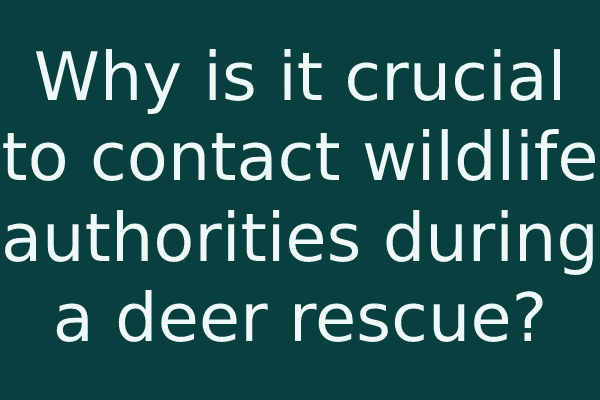Introduction:
In this article, we delve into the critical importance of contacting wildlife authorities during a deer rescue. When encountering a situation where a deer appears to be in distress or requires assistance, prompt and informed action is vital. While the instinct to help is admirable, it is essential to recognize that deer are wild animals with specific needs and behaviors. In this context, we will explore the reasons why reaching out to wildlife authorities is crucial during a deer rescue.
Wildlife authorities possess the expertise, training, and resources necessary to assess the situation accurately and make informed decisions regarding the deer's welfare. Their intervention ensures the safety of both the animal and those attempting to assist it. By understanding the role of wildlife authorities in deer rescues, individuals can contribute to the well-being and conservation of these majestic creatures while adhering to ethical and legal guidelines.
Professional Expertise and Training
Contacting wildlife authorities during a deer rescue is essential because these experts possess the professional expertise and training needed to handle wildlife safely and effectively. Wildlife authorities are typically trained in the behavior, biology, and needs of deer species. They understand how to approach and handle distressed or injured deer without causing unnecessary stress or harm.
Additionally, wildlife authorities have access to specialized equipment and resources, such as tranquilizers, nets, and transportation facilities, which are crucial for a successful deer rescue. Their knowledge and tools enable them to assess the situation accurately and make informed decisions about whether the deer requires rescue, rehabilitation, or relocation.
Protection of the Deer's Welfare
The primary objective of contacting wildlife authorities during a deer rescue is to ensure the welfare and well-being of the deer. These professionals prioritize the deer's safety and health above all else. When individuals attempt to rescue a deer without proper training or understanding, there's a risk of unintentional harm to the animal or the rescuer.
Wildlife authorities can assess the deer's condition and determine the most appropriate course of action. They may decide to provide medical care, rehabilitate the deer, or, if necessary, release it back into the wild. Their actions are guided by ethical principles and a commitment to the animal's best interests, ensuring that the deer has the highest chance of survival and a successful return to its natural habitat.
Understanding Legal Regulations
Wildlife authorities are well-versed in the legal regulations governing the rescue and handling of wild animals, including deer. These regulations are in place to protect both wildlife and human safety. Attempting to rescue a deer without knowledge of these laws can lead to legal consequences.
By involving wildlife authorities, individuals ensure that they are acting within the bounds of the law. Authorities can obtain the necessary permits and permissions for the rescue, ensuring that all actions are compliant with local, state, and federal wildlife regulations. This approach not only safeguards the deer but also avoids potential legal complications for those involved in the rescue.
Minimizing Human-Animal Conflict
Deer, while generally gentle animals, can become stressed and agitated when approached by humans, especially if they perceive a threat. Attempting to rescue a deer without the expertise of wildlife authorities can lead to unintentional conflicts that endanger both the rescuer and the deer.
Wildlife authorities understand how to minimize human-animal conflict during rescue operations. They use techniques that reduce stress on the deer, such as sedation when necessary, and ensure that the rescue process is as non-disruptive as possible. Minimizing conflict not only protects human safety but also increases the likelihood of a successful rescue and the deer's eventual return to the wild.
Preserving Ecosystem Health
Deer plays a vital role in ecosystems by influencing vegetation and serving as prey for predators. When a deer requires rescue, it is often because of a specific health issue or injury that could disrupt its ecological role. Wildlife authorities consider the broader impact on the ecosystem when deciding how to handle a deer rescue.
By involving experts, individuals contribute to preserving the overall health and balance of the ecosystem. Wildlife authorities can assess whether the deer's health issue is a result of environmental factors or human interference. This knowledge helps inform conservation efforts and ensures that any underlying ecological concerns are addressed during the rescue and rehabilitation process.
Data Collection for Conservation
Deer rescues provide valuable opportunities for data collection and research that contribute to conservation efforts. Wildlife authorities often gather information about the deer's condition, habitat, and behavior during the rescue process. This data aids in understanding the challenges deer face in the wild and can inform strategies for their conservation and management.
Additionally, rescued deer that require medical care or rehabilitation may be fitted with tracking devices or collars before release. This allows authorities to monitor their post-release activities, survival rates, and habitat preferences, contributing to ongoing conservation research.
By working with experts, individuals ensure that deer in need receive the best care and support while also contributing to the broader efforts to protect and conserve these magnificent creatures in their natural habitats.
Conclusion:
I hope this exploration of the importance of contacting wildlife authorities during a deer rescue underscores the critical role these experts play in safeguarding the welfare of both the deer and the humans involved. From their professional expertise and commitment to the deer's well-being to their understanding of legal regulations and ability to minimize conflict, wildlife authorities ensure that rescues are conducted safely, ethically, and in accordance with conservation principles.
By collaborating with these experts, individuals not only protect the deer but also contribute to the preservation of ecosystem health and the advancement of vital conservation efforts. The data collected during deer rescues serves as a valuable resource for ongoing research and informs strategies for the sustainable management of deer populations.
In essence, involving wildlife authorities in deer rescues reflects a responsible and ethical approach that upholds the best interests of these graceful creatures and their environments. It is a testament to our commitment to coexist harmoniously with wildlife while striving to protect and conserve the natural world we share.








0 Comments